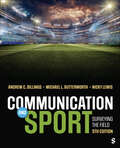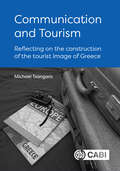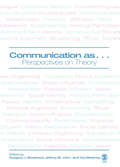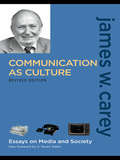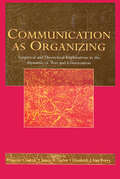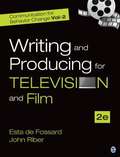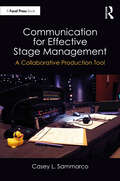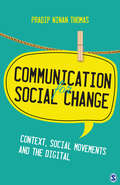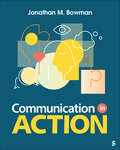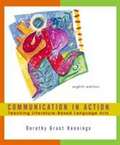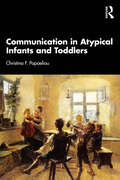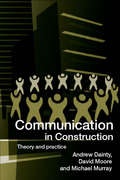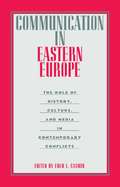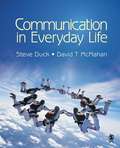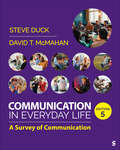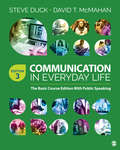- Table View
- List View
Communication and Sport: Surveying the Field
by Andrew C. Billings Michael L. Butterworth Nicky LewisCommunication and Sport: Surveying the Field examines a wide array of topics necessary for students to understand sports media, rhetoric, culture, and organizations from micro to macro-level issues. Everything from youth to amateur to professional sports is addressed through varied useful lens such as mythology, community, and identity. Communication and Sport introduces readers to the traditions and vocabulary found in communication scholarship as it then explains what distinguishes communication from related disciplinary approaches, such as sociology, anthropology, history, and cultural studies. Subsequent chapters explore such issues as: fan cultures; racial identity and gender in sports media; politics and nationality in sports; parent/child relationships and player/coach interactions in sports; sports and religion; and crisis communication in sports organization. In response to changes in the sporting landscape, the Fifth Edition features an extensive structural change and reorganization with newly designed units and chapters in addition to introducing a new coauthor Nicky Lewis.
Communication and Sport: Surveying the Field
by Andrew C. Billings Michael L. Butterworth Nicky LewisCommunication and Sport: Surveying the Field examines a wide array of topics necessary for students to understand sports media, rhetoric, culture, and organizations from micro to macro-level issues. Everything from youth to amateur to professional sports is addressed through varied useful lens such as mythology, community, and identity. Communication and Sport introduces readers to the traditions and vocabulary found in communication scholarship as it then explains what distinguishes communication from related disciplinary approaches, such as sociology, anthropology, history, and cultural studies. Subsequent chapters explore such issues as: fan cultures; racial identity and gender in sports media; politics and nationality in sports; parent/child relationships and player/coach interactions in sports; sports and religion; and crisis communication in sports organization. In response to changes in the sporting landscape, the Fifth Edition features an extensive structural change and reorganization with newly designed units and chapters in addition to introducing a new coauthor Nicky Lewis.
Communication and Tourism: Reflecting on the construction of the tourist image of Greece
by Dr Michael TsangarisThe nexus of human mobility and communication is intricate, and this volume uncovers the deep-rooted significance of tourism and media . From antiquity to modern day, Western communication systems have artfully crafted the allure of destinations, making places irresistible to the travellers. At its core, this book proposes that the impetus for travel is a primal human necessity, rooted in our inherent need for movement, consciousness expansion, and cultural development. Featuring Greek civilization as a case study, the book reveals how the rich cultural capital of modern Greece, long admired and assimilated by many global cultures, has immensely contributed to Greece's contemporary tourism "imaginary". Readers are challenged to look beyond prevailing practices where tourism management and marketing are the driving force for commercial exchange, but to encompass its broader essence as a vital human function, leading to richer experiences. Drawing on theory from communication studies, social psychology, social anthropology, cultural and tourism studies the book is: · an historical panorama, exploring how communication has continually influenced the allure of tourist destinations · an overview of philosophical essence of tourism as a basic human need intertwined with consciousness expansion. · written in an engaging style to stimulate thought in current issues around the tourism industry It will be of interest to academics within areas related to tourism studies, mobility studies, mass media, communication and cultural studies.
Communication as ...: Perspectives on Theory
by Ted Striphas Dean Gregory J. Shepherd Professor Jeffrey St. JohnIn Communication as...: Perspectives on Theory, editors Gregory J. Shepherd, Jeffrey St. John, and Ted Striphas bring together a collection of 27 essays that explores the wide range of theorizing about communication, cutting across all lines of traditional division in the field. The essays in this text are written by leading scholars in the field of communication theory, with each scholar employing a particular stance or perspective on what communication theory is and how it functions. In essays that are brief, argumentative, and forceful, the scholars propose their perspective as a primary or essential way of viewing communication with decided benefits over other views.
Communication as Comfort: Multiple Voices in Palliative Care (Routledge Communication Series)
by Sandra L. Ragan Elaine M. Wittenberg-Lyles Joy Goldsmith Sandra Sanchez ReillyThis exceptional work explores the complexities of communication at one of the most critical stages of the life experience--during advanced, serious illness and at the end of life. Challenging the predominantly biomedical model that informs much communication between seriously ill and/or dying patients and their physicians, caregivers, and families, Sandra L. Ragan, Elaine M. Wittenberg-Lyles, Joy Goldsmith, and Sandra Sanchez-Reilly pose palliative care--medical care designed to comfort rather than to cure patients--as an antidote to the experience of most Americans at the most vulnerable juncture of their lives. With an author team comprised of three health communication scholars and one physician certified in geriatrics and palliative medicine, this volume integrates the medical literature on palliative care with that of health communication researchers who advocate a biopsychosocial approach to health care. Applying communication theories and insights to illuminate problems and to explain their complexities, the authors advocate a patient-centered approach to care that recognizes and seeks to lessen patients’ suffering and the many types of pain they may experience (physical, psychological, social, and spiritual) during life-threatening illness.
Communication as Culture, Revised Edition: Essays on Media and Society
by James W. CareyIn this classic text, James W. Carey maintains that communication is not merely the transmission of information; reminding the reader of the link between the words "communication" and "community," he broadens his definition to include the drawing-together of a people that is culture. In this context, Carey questions the American tradition of focusing only on mass communication's function as a means of social and political control, and makes a case for examining the content of a communication—the meaning of symbols, not only the motives that originate them or the purposes they serve. He seeks to recast the goal of communication studies, replacing the search for deterministic laws of behavior with a simpler, yet far more challenging mission: "to enlarge the human conversation by comprehending what others are saying." This new edition includes a new critical foreword by G. Stuart Adam that explains Carey's fundamental role in transforming the study of mass communication to include a cultural perspective and connects his classic essays with contemporary media issues and trends. This edition also adds a new, complete bibliography of all of Carey's writings.
Communication as Organizing: Empirical and Theoretical Explorations in the Dynamic of Text and Conversation (Routledge Communication Series)
by James R. Taylor Elizabeth J. Van Every François CoorenCommunication as Organizing unites multiple reflections on the role of language under a single rubric: the organizing role of communication. Stemming from Jim Taylor's earlier work, The Emergent Organization: Communication as Its Site and Surface (LEA, 2000), the volume editors present a communicational answer to the question, "what is an organization?" through contributions from an international set of scholars and researchers. The chapter authors synthesize various lines of research on constituting organizations through communication, describing their explorations of the relation between language, human practice, and the constitution of organizational forms. Each chapter develops a dimension of the central theme, showing how such concepts as agency, identity, sensemaking, narrative and account may be put to work in discursive analysis to develop effective research into organizing processes. The contributions employ concrete examples to show how the theoretical concepts can be employed to develop effective research. This distinctive volume encourages readers to discover and develop a truly communicational means of addressing the question of organization, addressing how organization itself emerges in the course of communicational transactions. In presenting a single and entirely communicational perspective for exploring organizational phenomena, grounded in the discourse of communicational transactions and the establishment of relationships through language, it is required reading for scholars, researchers, and graduate students working in organizational communication, management, social psychology, pragmatics of language, and organizational studies.
Communication at A Distance: The Influence of Print on Sociocultural Organization and Change (Routledge Communication Series)
by Kathleen M. Carley David S. KauferThis book bridges an important gap between two major approaches to mass communication -- historical and social scientific. To do so, it employs a theory of communication that unifies social, cultural and technological concerns into a systematic and formal framework that is then used to examine the impact of print within the larger socio-cultural context and across multiple historical contexts. The authors integrate historical studies and more abstract formal representations, achieving a set of logically coherent and well-delimited hypotheses that invite further exploration, both historically and experimentally. A second gap that the book addresses is in the area of formal models of communication and diffusion. Such models typically assume a homogeneous population and a communication whose message is abstracted from the complexities of language processing. In contrast, the model presented in this book treats the population as heterogeneous and communications as potentially variable in their content as they move across speakers or readers. Written to address and overcome many of the disciplinary divisions that have prevented the study of print from being approached from the perspective of a unified theory, this book employs a focused interdisciplinary position that encompasses several domains. It shows the underlying compatibility between cognitive and social theory; between the study of language and cognition and the study of technology; between the postmodern interest in the instability of meaning and the social science interest in the diffusion of information; between the effects of technology and issues of cultural homogeneity and heterogeneity. Overall, this book reveals how small, relatively non-interactive, disciplinary-specific conversations about print are usefully conceived of as part of a larger interdisciplinary inquiry.
Communication for Behavior Change
by Esta De Fossard John RiberThe book demonstrates how to create TV and FILM DRAMAS that encourage people to make positive behavioral changes to improve their lives. The book teaches people how to: * Create SERIAL OR STAND-ALONE DRAMAS that will appeal to a select audience * Create characters that represent and attract the target audience * Introduce subtle and convincing ways to improve the standard of living of the audience * Conduct design workshops for preparing design documents that help script writers create 'convincing' dramas containing the behavior-change message accurately
Communication for Effective Stage Management: A Collaborative Production Tool
by Casey L. SammarcoCommunication for Effective Stage Management: A Collaborative Production Tool provides a comprehensive examination of communication theory through the lens of effective stage management and offers ideas and methods for stage managers to enhance their communicative presence throughout a theatrical process.This book offers new, extensive in-depth discussion of communication techniques and how these methods apply to the role of the theatrical stage manager as the facilitator of information. Part I dives into the methods and principles of business communication employed by stage managers and discusses how these techniques are best implemented throughout a theatrical process, all supported with real-life examples. It also offers discussion questions and resources to enhance the content and encourages the reader to self-analyze their own communication techniques during the production process. Part II contains excerpts from other industry professionals who offer their own unique perspective as to the collaborative and communicative work of stage managers and how their own artistic careers are impacted by the communication systems of a stage management team.This book is best suited for advanced stage management students, professional theatre practitioners, and theatrical educators.
Communication for Social Change: Context, Social Movements and the Digital
by Pradip Ninan ThomasCommunication for Social Change: Context, Social Movements and the Digital is a critical introduction to communication for social change (CSC) theory. The book presents refreshingly new perspectives and specifically makes the case for CSC theory to factor in context, leanings from social movements and a critique of the digital technology. This book offers perspectives on the historical continuities within this field of study along with the departures that have been hastened and shaped by confluences between ideas and practice as well as by digital technology and social movements. It introduces readers to a raft of new theorists of CSC and puts forth new thinking, new ideas, and a new basis for theorisation of communication for social change.
Communication in Action
by Jonathan Michael BowmanThrough a narrative, practical approach enriched with inclusive examples, Communication in Action inspires students to think critically about the role of effective communication in driving meaningful change within their own lives and communities. Author Jonathan Bowman empowers students to apply fundamental communication principles in daily life, fostering self-awareness and an understanding of diverse perspectives. Each chapter includes activities that motivate students to engage with their online and in-person social networks, practicing effective communication for personal and professional growth. Bowman also challenges students to confront issues of power, privilege, and social justice by encouraging them to take impactful actions—whether through direct interaction or civic involvement and engagement. With engaging discussions of core concepts and contemporary examples, this text not only encourages students to explore how effective communication can drive change in their lives but also inspires a new wave of communicators committed to fostering community well-being.
Communication in Action
by Jonathan Michael BowmanThrough a narrative, practical approach enriched with inclusive examples, Communication in Action inspires students to think critically about the role of effective communication in driving meaningful change within their own lives and communities. Author Jonathan Bowman empowers students to apply fundamental communication principles in daily life, fostering self-awareness and an understanding of diverse perspectives. Each chapter includes activities that motivate students to engage with their online and in-person social networks, practicing effective communication for personal and professional growth. Bowman also challenges students to confront issues of power, privilege, and social justice by encouraging them to take impactful actions—whether through direct interaction or civic involvement and engagement. With engaging discussions of core concepts and contemporary examples, this text not only encourages students to explore how effective communication can drive change in their lives but also inspires a new wave of communicators committed to fostering community well-being.
Communication in Action: Teaching Literature-Based Language Arts (Eighth Edition)
by Dorothy HenningsCommunication in Action integrates the language arts--speaking, listening, viewing, reading, and writing--into a total curriculum that centers around children's literature. The text includes ideas for using literature to teach language skills across the curriculum, and a planning resource handbook at the end of the text that helps teachers create lesson plans, select children's books, and evaluate software options.
Communication in Atypical Infants and Toddlers
by Christina F. PapaeliouThis book presents a comparative review of the latest studies and data on prelinguistic communication and early semantic development in autism spectrum disorder (ASD), Williams syndrome (WMS), attention-deficit/hyperactivity disorder (ADHD), and early language delay. Papaeliou offers a critical analysis of the literature, compares key theoretical approaches, and interprets data on development in atypical populations.A fruitful synthesis of theory and research reveals that, instead of cognitive deficits, the core feature of these neurodevelopmental disorders consists of deficits in the ability for self- and intersubjective coordination, which adversely affects early interactions and, consequently, the emergence of language. The book composes fragmentary proposals on the role of rhythm disruptions in different conditions, setting out the idea that disruption in interactional synchrony is a connecting thread through neurodevelopmental disorders which show high prevalence or high comorbidity rates. Papaeliou identifies distinct communicative patterns characteristic of each disorder and puts forward a unifying theory for interpreting data on early communication and language development in atypical populations.This is ideal reading for psychologists, psycholinguists, psychiatrists, paediatricians, speech therapists, and special educators. Students in developmental psychology and anyone interested in understanding the research behind typical and atypical development will also benefit from this text.
Communication in Construction: Theory and Practice
by Michael Murray David Moore Andrew DaintyCommunication within project-based environments presents special challenges. This is especially true within the construction industry, where interaction tends to be characterised by unfamiliar groups of people coming together for short periods before disbanding to work on other endeavours. This book examines communication at a number of levels ranging from interpersonal interactions between project participants to corporate communication between organizations. Several non-typical perspectives on the process of communication are introduced to encourage the reader to think about communication in a more innovative manner. The combination of differing perspectives illustrates the diversity of communication problems facing those working within project-based environments. Practical guidance is provided on possible solutions to communication problems, and a number of examples and case studies are presented.
Communication in Eastern Europe: The Role of History, Culture, and Media in Contemporary Conflicts (Routledge Communication Series)
by Fred L. CasmirThis volume represents a clear attempt to learn something from the events in Eastern European countries. It does not start with simplistic or old assumptions based on convenient Western communication models, but instead takes a new approach. If chaos theory could fundamentally change how physicists looked at order in the universe, then it may be of value for communication scholars to attempt to understand the diversity of chaos or order in the human universe, rather than attempt to force existing models on it for their own explanatory purposes. This book is not merely based on the study of select groups of university students or on laboratory settings created in the minds of social scientists. It seeks to understand some of the "real world," including the historical backgrounds and the theoretical assumptions brought to studies of intercultural conflicts. Using personal and professional insights developed during firsthand contacts with existing situations, chapter authors illustrate some of the realities by using the complexity of changes in Eastern European states during the final decade of the 20th century. From education to business, from the role of women to the role of mass media, from the impact of political systems to the impact of history, communication between those who are culturally diverse, though they may have been arbitrarily forced to live under the same "political roof," is the theme of these scholarly studies. The editor's reason for developing this volume of original essays is his belief that diversity rather than assumed similarity or even sameness -- based on the use of inadequate terminology -- is necessary for learning from contemporary human experiences. He further believes that diversity and the significant roles of cultural values as well as of history need to become key concepts in the model with which to begin when it comes to the study of various aspects of intercultural communication. It is therefore vital that scholars who represent various points of view and backgrounds contribute to that process. After all, understanding what is happening in the world is centrally anchored in or related to effective and successful "intercultural" communication between scholars who have different academic and personal backgrounds.
Communication in Everyday Life
by Steve Duck David T. McmahanCommunication in Everyday Life is the first survey of communication textbook to explore fundamental communication concepts, theories, skills, and contexts with a thematic integration-the relational perspective-to everyday life that allows all of these things to cohere.
Communication in Everyday Life: A Survey of Communication
by Steve Duck David T. McMahanExplore fundamental communication concepts, theories, and skills aimed at helping students apply communication skills to their personal and professional lives—with a thematic integration of the relational perspective and a focus on demonstrating its direct relevance to their own everyday communication.
Communication in Everyday Life: A Survey of Communication
by Steve Duck David T. McMahanCommunication in Everyday Life: A Survey of Communication offers an engaging introduction to communication based on the belief that communication and relationships are always interconnected. Best-selling authors Steve Duck and David T. McMahan incorporate this theme of a relational perspective and a focus on everyday communication to show the connections between concepts and how they can be understood through a shared perspective. Students will learn how topics in communication come together as part of a greater whole, as well as gain practical communication skills, from listening to critical thinking and using technology to communicate.
Communication in Everyday Life: A Survey of Communication
by Steve Duck David T. McMahanCommunication in Everyday Life: A Survey of Communication offers an engaging introduction to communication based on the belief that communication and relationships are always interconnected. Best-selling authors Steve Duck and David T. McMahan incorporate this theme of a relational perspective and a focus on everyday communication to show the connections between concepts and how they can be understood through a shared perspective. Students will learn how topics in communication come together as part of a greater whole, as well as gain practical communication skills, from listening to critical thinking and using technology to communicate.
Communication in Everyday Life: A Survey of Communication
by Steve Duck David T. McMahanCommunication in Everyday Life explores fundamental concepts, theories, and skills, enabling students to apply the material to their personal and professional lives. With a thematic integration of the relational perspective and a focus on demonstrating its direct relevance to their own everyday communication, authors Steve Duck and David T. McMahan help students build a strong foundation in communication concepts, theory, and research, while developing practical skills such as listening, critical thinking, effective use of technology, understanding nonverbal communication, creating persuasive strategies, and managing group conflicts. With updated coverage of media and technology, new examples, and updated references, the Fifth Edition offers timely insights into modern communication topics central to everyday life.
Communication in Everyday Life: A Survey of Communication
by Steve Duck David T. McMahanCommunication in Everyday Life explores fundamental concepts, theories, and skills, enabling students to apply the material to their personal and professional lives. With a thematic integration of the relational perspective and a focus on demonstrating its direct relevance to their own everyday communication, authors Steve Duck and David T. McMahan help students build a strong foundation in communication concepts, theory, and research, while developing practical skills such as listening, critical thinking, effective use of technology, understanding nonverbal communication, creating persuasive strategies, and managing group conflicts. With updated coverage of media and technology, new examples, and updated references, the Fifth Edition offers timely insights into modern communication topics central to everyday life.
Communication in Everyday Life: A Survey of Communication
by Steve Duck David T. McmahanExplore fundamental communication concepts, theories, and skills aimed at helping students apply communication skills to their personal and professional lives—with a thematic integration of the relational perspective and a focus on demonstrating its direct relevance to their own everyday communication.
Communication in Everyday Life: The Basic Course Edition With Public Speaking
by Steve Duck David T. McMahanCommunication in Everyday Life: The Basic Course Edition With Public Speaking offers an engaging look at the inseparable connection between relationships and communication. Best-selling authors Steve Duck and David T. McMahan expertly combine theory and application to introduce students to communication fundamentals. The book provides a strong foundation in communication concepts, theory, and research, while helping readers master practical communication skills such as listening and critical thinking, using technology to communicate, understanding nonverbal communication, creative persuasive strategies, and managing group conflict.
